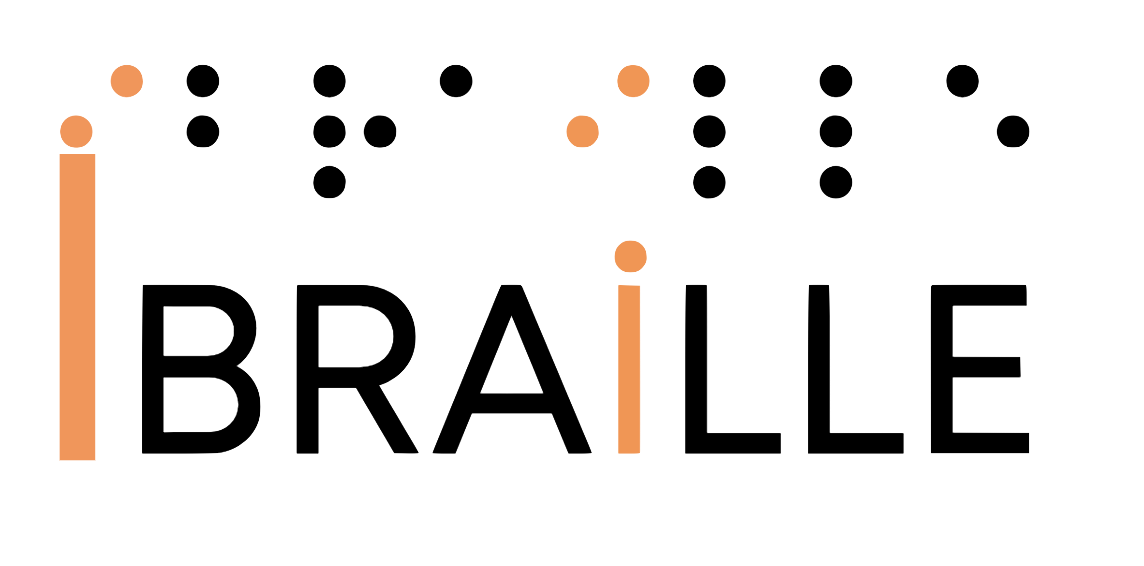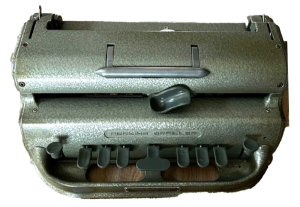Make a big impact through Braille accessibility
We provide unique services to help you improve the accessibility and usability of your products and services and the environments where they are located. Services you can trust to deliver superior results from experts who have an intimate understanding of how accessibility works.
An image of a Perkins Brailler. Photo Credit: iBraille
Why Braille accessibility?
There are at least 2.2 billion people with visual impairment worldwide. That is why Braille literacy is essential. Therefore, incorporating Braille into an overall accessibility package will make a world of difference, when done right. See for yourself in this beautiful video by Haben Girma, Harvard Law’s first deafblind graduate, disability rights attorney, accessibility consultant and author of Haben: The Deafblind Woman Who Conquered Harvard Law.
Video Transcript
Scene: Haben stands by a large display with a tower that stands about three feet tall. In the background are displays of statutes and monuments, including the Roman Colosseum, the Kremlin, the Parthenon, the Eiffel Tower, the Taj Mahal, and The Hagia Sophia Grand Mosque.
Haben: We have a braille label here. Torre de Pisa. Pisa, Italia. So it’s a curved tower with columns on top of columns.
You know, they always talk about the Tower of Pisa leaning. And I imagined a really dramatic lean. But this is more of a subtle lean, not as dramatic as I expected.
Scene: Haben reads a braille label at another display.
Haben: Pirámide de Chichen Itzá. Yucatan, México. Spanish and English braille are fairly similar, but there is some characters and punctuation that’s different. So I have to pause and try to remember my high school Spanish to read it. So here we have the pyramid, and it’s kind of a rectangular style, very flat, smooth top roof. And along four sides are the stairs. My family and I visited many years ago. And I remember when I was climbing up the stairs, a woman commented, “Wow! if she can do it, I can do it.” And my blindness wasn’t really a factor. I have the ability to walk. Blindness doesn’t impact my ability to walk.
Scene: Photo of Haben exploring a model of a gorgeous, brightly painted church. Her Seeing Eye dog is lying on the floor watching.
Haben: I’m in the ONCE Museum for the Blind in Madrid, Spain. It’s the only place where I’ve been able to touch world monuments all in one room. There’s another room dedicated to Spanish monuments, such as the Basilica of Zaragoza. It is large! And has so many domes and towers! Wouldn’t it be amazing if every country had a museum like this?
Going beyond the basics
Existing automated accessibility tools and guidelines do not fully capture all aspects of an accessible user experience. As a result, you get a false sense of satisfaction that your products or services meet the needs of all user groups, potentially exposing you to significant liability. We go beyond the basics by providing comprehensive, hands-on testing. In this manner, we elevate the accessibility of your product or service.
Future-proof your accessibility compliance
Organizations face significant challenges in navigating a complex and evolving regulatory environment. By working closely with a company run by professionals who are end users with years of experience providing accessible technology training and consulting services, we can help you future-proof compliance or quickly adapt to a different regulatory landscape. By using our services, you demonstrate your ongoing commitment to genuine accessibility and compliance efforts.
Accessibility means sustainability

Credit: Photo by Dnanny; artistic design by Tany Glohaven.
Full Image Description
In the center there is a huge tree and some smaller trees at the background. The tree has green leaves with some orange leaves.
There is a gazebo on the left side at the back. At the right back, there are art structures.
The family standing at the front is four characters, all blind. They are all smiling. There is a dog.
Starting with the left: A young teen girl is holding a cane and has a strap around her right wrist. The girl is wearing purple top with green shorts. She has red hair tied back. Her eyes are gazing a bit upward and to the right.
The cane is out, the pink tip is showing. In her left hand, she holds a handle to the dog harness. The dog is sitting at attention. It’s a golden retriever. There is a wide strap across its chest.
Behind the dog, stands a woman. She is holding her cane upright at her center, her right hand is relaxing on the top part of cane. The left hand is gripping the cane handle. The woman has her eyes closed. She is wearing yellow/orange tank top with yellow and pink mid length skirt. Her hair is blond, with sunglasses perched on top of her head.
Next to the dog is a young child, a boy wearing green shirt, brown pants. He is holding a folded cane across his chest. There is a blue tip and blue stripe showing on the folded cane. He has curly orange hair, one brown eye which he could see through.
Right next to the child is a man, African American, wearing a plaid blue/purple button down and short sleeve shirt. He is wearing glasses. He wears a brown pair of pants with a belt. He is holding out one cane with 2 red stripes and black tip with his left hand. His other hand is mostly hidden behind the boy.
A socially responsible organization like yours wants to make a real difference in the world. In this case, it means actively being a part of a global movement to build a world that is just as sustainable as it is universally accessible. Reducing inequalities is one of the United Nations’ Sustainable Development Goals (SDGs). By making their products and services accessible to everyone anywhere in the world, organizations uphold their commitment to sustainable development. For businesses, it also means making customers and shareholders who care deeply about sustainability and inclusion happy.
Experience the iBraille difference
At iBraille LLC, we leverage our extensive experience with accessibility testing and deep knowledge of Braille-based technologies to deliver unparalleled services. Here are some examples of what distinguishes us from other accessibility testing companies:
- Almost all accessibility testers may know Braille but do not use it regularly. The result? Organizations find themselves scrambling to remedy serious Braille accessibility problems.
- Our experts understand and use Braille like it is their native language. They use Braille every single day. This allows them to efficiently diagnose accessibility problems and generate insightful recommendations.
- We build and strengthen crucial relationships between technology companies and the Braille user community to promote innovation in Braille accessibility.
- We closely monitor new developments on the accessibility policy front to understand what implications new regulations may have on accessibility requirements so that we can best tailor our services to meet the needs of our customers. And,
- We stay on top of the latest accessibility guidelines and, where applicable, incorporate them into our services.
Experience the iBraille difference today. Request a quote if you are ready to make a big impact tomorrow. Contact us if you want to learn more about our exceptional services that will transform your organization down the road.

